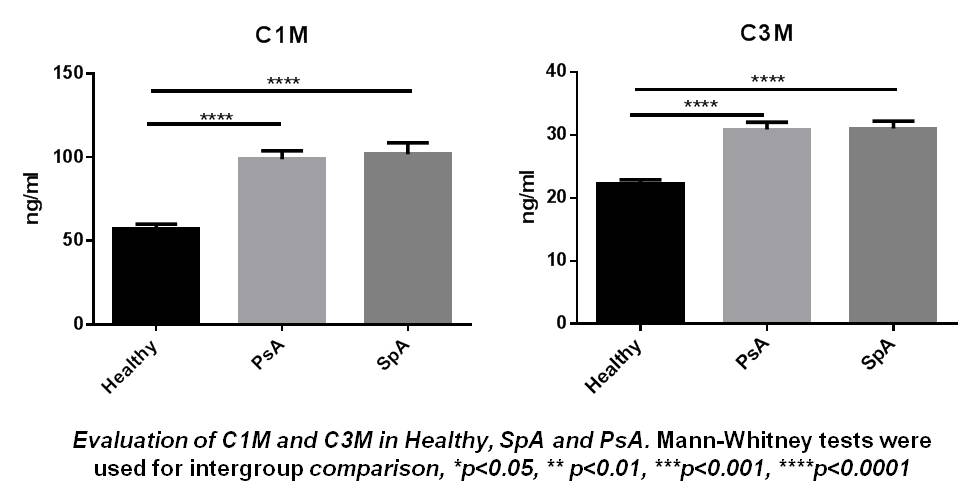Session Information
Date: Monday, November 9, 2015
Title: Spondylarthropathies and Psoriatic Arthritis - Comorbidities and Treatment Poster II
Session Type: ACR Poster Session B
Session Time: 9:00AM-11:00AM
Background/Purpose: AxSpA
and PsA are core members of the spondyloarthritis
complex. One cardinal characteristic shared by these two conditions is
increased remodeling of bone and soft connective tissue in and around
peripheral joints, axial skeleton and entheseal
insertions leading to synovitis, enthesitis
and ankylosis in advanced disease. Studies using seromarkers which reflect extracellular matrix constituent
metabolism may provide insight into the activity and dynamics of
connective remodeling and thereby pave the way for improved diagnostics and
management. The aims of this investigation were to study C1M and C3M, which
reflect the turnover of collagen I and III, in order to assess their
utility as diagnostic and disease activity markers.
Methods: Ninety-nine patients with PsA,
110 with axSpA and 120 healthy control subjects were
included. Demographic and clinical disease measures were recorded.C1M and C3M
were quantified using in house competitive ELISAs. Biomarker results are
presented as median with 95% CI. Mann Whitney test was applied for inter-group
comparisons and correlations were studied using Spearmans
test. Receiver operator characteristics (ROC) curve analysis was carried
out to evaluate the diagnostic potential of the biomarkers.
Results: C1M and C3M were significantly increased in
both axSpA and PsA as
compared with healthy controls (Figure). Thus, in axSPA
C1M and C3M amounted to 77.6 (71.3-84.6)ng/ml and
27.7 (26.2-29.7)ng/ml respectively, in PsA to 85.6 (78.2-96.2)ng/ml and
28.7 (26.7-31.0)ng/ml versus controls 48.3(43.3-53.2)
and 20.9 (20.0-21.7) respectively. C1M and C3M levels did not differ
significantly between axSpA and PsA.
Serum levels of C1M and C3M were not affected by treatment, or smoking status,
but SpA HLA-B27+ patients had significantly higher
levels of both C1M (p=0.001) and C3M (p=0.006) compared to HLAB-27- SpA patients. C1M was significantly correlated with DAS28 (PsA: r=0.22, p=0.028, SpA:
r=0.40, p<0.0001) and ASDAS (PsA: r=0.29, p=0.003,
SpA:r=0.35, r=0.0002). Also
C3M was significantly correlated with DAS28 (PsA:
r=0.22, p=0.025, SpA: r=0.74, p<0.0001) and ASDAS
(PsA: r=0.32, p=0.0013, SpA:
r=0.216, p=0.026). C1M and C3M were highly correlated (p>0.0001 in all
groups) but they did not correlate with demographics including age, BMI or
gender. Segregation between healthy and diseased based on C1M levels resulted
in an AUC of 0.83 for PsA (0.76-0.86) and 0.79
(0.73-0.84) for SpA. C3M could also segregate between
healthy and diseased with an AUC of 0.77 (0.71-0.82) for PsA
and 0.78 (0.72-0.83) for SpA.
Conclusion: These findings indicate that soft connective
tissue remodeling is equally increased in axSpA and PsA reflecting disease activity and that collagen type
I and III turnover are mediated by closely coupled mechanisms. ROC curve
analyses suggest that both C1M and C3M may be useful for diagnostic purposes in
axSpA and PsA.
To cite this abstract in AMA style:
Gudman NS, Christensen AF, Sørensen GL, Bay-Jensen AC, Siebuhr AS, Karsdal MA, Munk HL, Ejstrup L, Loft AG, Junker P. Fingerprint Biomarkers of Type I and III Collagen in Axial Spondyloarthropathy (axSpA) and Psoriatic Arthritis (PsA). Association with Disease Activity and Diagnostic Capacity [abstract]. Arthritis Rheumatol. 2015; 67 (suppl 10). https://acrabstracts.org/abstract/fingerprint-biomarkers-of-type-i-and-iii-collagen-in-axial-spondyloarthropathy-axspa-and-psoriatic-arthritis-psa-association-with-disease-activity-and-diagnostic-capacity/. Accessed .« Back to 2015 ACR/ARHP Annual Meeting
ACR Meeting Abstracts - https://acrabstracts.org/abstract/fingerprint-biomarkers-of-type-i-and-iii-collagen-in-axial-spondyloarthropathy-axspa-and-psoriatic-arthritis-psa-association-with-disease-activity-and-diagnostic-capacity/

